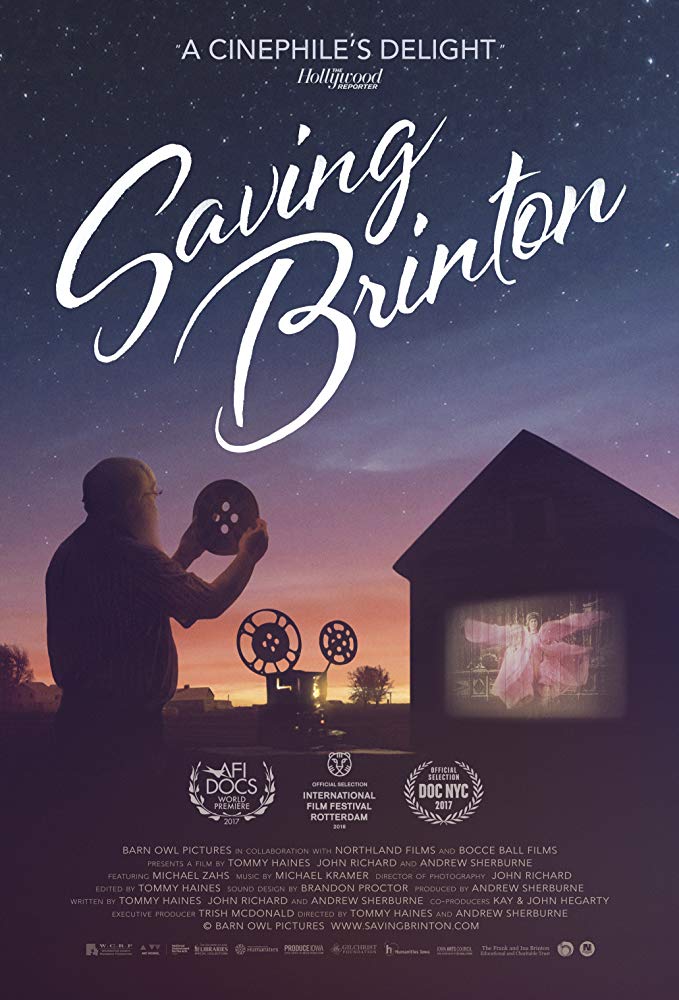Saving Brinton (2018)


SHOULD I SEE IT?
YES
Does what great human-interest documentaries often do - they give us a remarkable story and an affable character, or narrator of sorts, to guide us through the discoveries right alongside them.
Film historians and cinephiles will be amazed at what archivist/collector Michael Zahs reveals was in a room of his house for over three decades.
Reminds us that we all leave an impact, long after we are gone.
NO
The film may lose some viewers along the way, including those who become less interested in the film history the movie shares.
Hardly offensive in any stretch of the word, but the movie does raise some questions, through some of the material uncovered, that it has no interest in answering.
Perhaps a tough sell for mainstream audiences, though all the components exist here for a entertaining, slice-of-life movie. The premise feels limiting and could wall off potential viewers.
OUR REVIEW
It takes all of about three minutes for us to become enamored with the collector, accumulator, historian, former professor, and archivist Michael Zahs, the man who provides the heart that beats proud within the new documentary Saving Brinton. With his long, graying beard, congenial sense about himself, and self-deprecating wit and enthusiasm for lots and lots of things, Zahs becomes a wonderful tour guide of sorts through a most unique and clever movie-related story.
The Iowa resident may apologize that his home will look like “one of those shows” on camera (that show would likely be “Hoarders,” if we are being honest…), but what he pulls out of a jam-packed, constricted room in his house is quite remarkable indeed.
Over the course of nearly 90 minutes, Zahs is given the platform to share the story of Frank and Indiana Brinton, a husband-and-wife tandem who spent just nearly a decade-and-a-half (1895-1909) touring the Midwest with a showcase of nitrate movie reels and moving picture exhibitions. Frank was something of a carnival barker in the infancy of cinema, projecting images with his one-of-a-kind “dissolving projector,” which allowed him to show two images concurrently using magic lantern slides. He ordered films from France and showed works of Georges Méliès, Edison, and other filmmaking pioneers in his roadshow. And all for just a few cents per show.
Zahs lays out the fortuitous luck he had in acquiring the thousands of artifacts and remnants from the Brinton estate. When Frank died in 1919, Indiana kept everything until her death in 1955. The executor of the Brinton estate kept all the materials, until offloading it to a willing collector, one Mr. Michael Zahs, in 1981. Zahs then turned a room of his farmhouse into “The Brinton Room” and, soon after the movie begins, a curator from the University of Iowa is among the first to set eyes on Zahs’ rather remarkable collection.
That Zahs and Brinton reside(d) in the same community makes these discoveries even more astonishing. As more and more pieces are looked at and explored, the Library of Congress takes an interest. We hear that Martin Scorsese, a prideful film archivist in his own right, had, at one time, expressed interest in the nitrate prints in Zahs’ possession. Perhaps the film’s most significant “A Ha!!” moments comes when it is revealed that two films, made by Méliès and long believed lost due to his famously burning of thousands of his prints in 1923, are found in and among the Brinton Collection.

This brings forth a tearful reaction from film preservationist Serge Bromberg, and it is not too long after the discovery that Zahs is soon showcasing the Méliès works at an Italian film festival, and later a silent film festival. And in a moment of great joy for subject and viewers alike, Zahs is recreating the Brinton roadshow at the longest running movie theater in the United States, The State Theater, in nearby Washington, Iowa.
Along the way, we see a story fit for Hollywood, told in and around the farming community of Ainsworth, Iowa, population ~600, beautifully shot and accentuated by cinematographer John Richard. Directors Tommy Haines and Andrew Sherburne simply and smartly follow Zahs’ lead and see where the story takes them.
While there are a few lingering questions that are glossed over and/or ignored among the items we see and the information uncovered, one need not be a fan of historical cinema to recognize that Saving Brinton becomes a joy to watch for anyone who has ever found something they hold dear, and thought that either no one cared about it as much as they did, or that something they felt was meaningful and important could be just as meaningful to a wider range of people.
Zahs’ smile and bubbling excitement, coupled the joy on the faces of those who experience Brinton and Méliès’ art really says it all: The legacy we leave behind, for those around us and those who come after us, may not only be felt for years or even decades.
Saving Brinton reminds us that perhaps the good we work to share with the world can has the potential to be felt for centuries.
CAST & CREW
Documentary Featuring: Michael Zahs, Serge Bomberg, Greg Pickman, Elaine Zahs, Kathryn Fuller-Sealey, Rick Altman.
Director: Tommy Haines, Andrew Sherburne
Written by: Tommy Haines, John Richard, Andrew Sherburne
Release Date: May 18, 2018
Barn Owl Pictures
